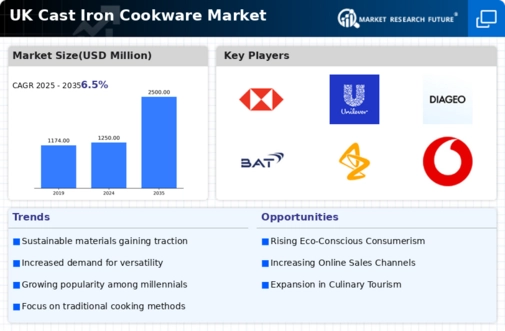Uk Cast Iron Cookware Size
UK Cast Iron Cookware Market Growth Projections and Opportunities
The UK cast iron cookware market is influenced by several key market factors that collectively shape its dynamics and growth patterns. One significant factor driving the market is the increasing trend of home cooking and culinary enthusiasts seeking high-quality, durable cookware. Cast iron cookware, known for its versatility and longevity, has gained popularity among consumers who prioritize performance and value for money. The rising interest in home cooking, coupled with the enduring appeal of traditional and artisanal kitchenware, contributes to the growth of the UK cast iron cookware market.
Government regulations and standards also play a pivotal role in shaping the market. Regulations related to product safety, material standards, and labeling impact the manufacturing, marketing, and sale of cast iron cookware. Compliance with these regulations is essential for manufacturers to ensure consumer safety and build trust in their products. Navigating the regulatory landscape is crucial for companies operating in the UK cast iron cookware market, as adherence to quality standards becomes a key differentiator.
Consumer preferences and lifestyle trends significantly influence the market dynamics. With an increasing focus on sustainable and eco-friendly products, consumers are drawn to cast iron cookware for its durability, recyclability, and energy efficiency. The timeless appeal of cast iron, coupled with its ability to retain and evenly distribute heat, resonates with environmentally conscious consumers. Market players need to align their product offerings with these shifting preferences and emphasize the sustainability aspects of cast iron cookware to stay competitive in the evolving market.
Research and development (R&D) initiatives contribute to product innovation within the UK cast iron cookware market. Ongoing research aims to enhance the performance, design, and features of cast iron cookware, meeting the evolving needs of consumers. Companies invest in R&D to introduce new product lines, improve manufacturing processes, and address any shortcomings in traditional cast iron cookware. This commitment to innovation is crucial for staying ahead in a competitive market and attracting consumers looking for modern and improved versions of classic kitchen essentials.
Economic factors, such as disposable income and purchasing power, play a role in shaping the market. Economic stability and growth contribute to increased consumer spending on premium and durable kitchenware. Conversely, economic downturns may lead to shifts in consumer spending patterns, impacting the market negatively. Companies need to be aware of these economic dynamics and adapt their strategies to navigate changing consumer behaviors and market conditions effectively.
The competitive landscape is characterized by factors such as brand reputation, marketing strategies, and product differentiation. Established brands with a history of producing high-quality cast iron cookware often enjoy a competitive advantage based on consumer trust and loyalty. Effective marketing, highlighting the unique features and benefits of cast iron cookware, helps companies distinguish their products in a crowded market. Differentiation through design, color options, and additional features also contributes to a brand's success in capturing diverse consumer preferences.
Moreover, the retail landscape and distribution channels play a crucial role in market accessibility. The presence of cast iron cookware in both traditional brick-and-mortar stores and online platforms expands the reach to a wider consumer base. Strategic partnerships with retailers, effective marketing campaigns, and an online presence contribute to the overall success of companies in the UK cast iron cookware market.










Leave a Comment